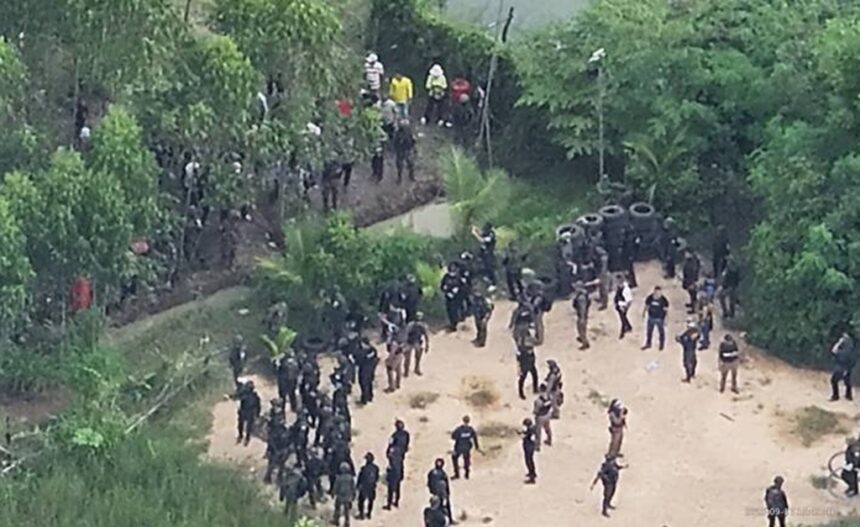SA KAEO – Tensions at the border between Thailand and Cambodia sharply increased on Wednesday, 17 September 2025. Thai riot police fired rubber bullets and tear gas at roughly 200 Cambodian protesters gathered in the disputed Ban Nong Ya Kaeo area of Sa Kaeo Province’s Khok Sung district.
This marked the first major use of force since a ceasefire in July. The clash left at least 23 Cambodians and several Thai police officers injured. Both countries quickly traded accusations in the aftermath of the violence, reviving old disagreements over the boundary.
The confrontation happened near markers 42 and 43, where Thai officials had recently set up razor wire and barricades, claiming to secure Thai land. The Royal Thai Army said some of the Cambodian protesters carried sticks, slingshots, and stones.
As they approached, they started removing the wire, which led to a police response. Major General Winthai Suvaree, the army spokesperson, explained that tension peaked at about 3:40 pm when protesters threw objects and injured four Thai officers. By 4:20 pm, riot police, led by Pol Maj Gen Thaworn Dulayawit, used tear gas, rubber bullets, and acoustic devices to push the crowd back.
Twenty Three People were Injured
Cambodian officials disputed Thailand’s version, insisting that the standoff happened inside Prey Chan village, over the border in Banteay Meanchey province. Cambodia’s Information Minister, Neth Pheaktra, accused Thai forces of crossing into Cambodian territory and overreacting with force, including the use of tear gas and sound cannons, against civilians.
Cambodia reported 23 people injured, including a Buddhist monk and a soldier. Social media from Cambodia, shared by journalist Mech Dara, showed villagers carrying sticks or gloves trying to stop what they called Thai encroachment. One video showed a monk and several locals removing barbed wire before Thai officers fired tear gas.
The dispute stems from a long and troubled history over the territory, made worse by a fragile ceasefire brokered in Malaysia on 28 July 2025. That agreement followed a deadly five-day conflict that killed at least 48 and forced hundreds of thousands from their homes.
Both Thailand and Cambodia claim the contested area, called Ban Nong Ya Kaeo by Thais and Prey Chan by Cambodians. Earlier in September, Thai authorities put up signs telling Cambodian villagers to leave, citing forestry and immigration violations.
In response, Cambodians, many with family links to the land, protested with the support of local officials. On 3 September, approximately 200 Cambodians staged a similar protest, which ended peacefully.
Thai Police Officer Assaulted
Wednesday’s clash followed a series of incidents that worsened tensions. On Tuesday, Cambodian villagers, with help from local leaders, tore down parts of the Thai wire fence, leading Sa Kaeo Governor Prinya Phothisat to file a protest with his Cambodian counterpart, Oum Reatrey, at the Poipet border crossing.
Thai authorities accused Cambodia of breaking the 2000 Memorandum of Understanding (MOU), which bans any actions that could change the border’s condition. Cambodia hit back, arguing that Thailand’s barriers and reported evictions in Chouk Chey and Prey Chan broke the ceasefire agreement.
Wider issues between the two countries add to the distrust. Long-running arguments over places like the Preah Vihear temple fuel strong nationalist views in both Thailand and Cambodia, which social media only amplifies.
Online posts from Cambodian users, including Sowanna Yun, called for help from the international community to defend Cambodian rights, while Thai outlets such as Khaosod News highlighted Thailand’s claim of restraint and sovereignty. Past flare-ups, including a fight in July with landmines and artillery, left many dead.
Border Police Blamed
Thailand reported nine civilians killed, while Cambodia blamed Thai police and forces for most of the violence. Martial law in Ban Nong Chan in August and the use of LRAD sound devices have shown the hard line taken by Thai forces.
Both Bangkok and Phnom Penh have urged calm. Cambodia’s Foreign Ministry demanded that Thailand stick to the July ceasefire and stop acts likely to trigger clashes. Thai leaders followed with a 30-day deadline for Cambodian evacuees to leave Ban Nong Ya Kaeo and Ban Nong Jan, and threatened legal action if they remained. Attention now turns to the General Border Committee meeting on 10 October, yet experts say a settlement is unlikely due to deep-rooted positions on both sides.
These border disputes disrupt community life and business. Cambodian villagers, many with long family traditions in the area, face eviction; Thai residents nearby worry about safety.
Business leaders in Thailand raised trade concerns, especially since Cambodia has asked people to boycott Thai goods. International players, including a Malaysian observer group, called for calm. The absence of an independent mediator makes progress hard to achieve.
As night approached on Wednesday, the border remained tense. Cambodian villagers set up camps nearby while Thai officers increased security at the boundary.
The standoff puts the recent ceasefire to the test and highlights the deep challenges in settling a historic dispute with powerful emotions and competing land claims. Without a breakthrough, the border could slip back into violence, putting the safety and stability of Southeast Asia’s frontier at risk.

















